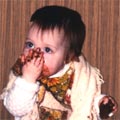Food for infants
Does a six month old baby have the same requirements for food that a four year old does?

Nutritional requirements during infancy are exceptionally high as infancy is a time of rapid growth and development. They triple their birth weight in the first year and increase in length by about 50%.
Protein and calcium are absolutely essential for the growing and increasingly active infant. From six months they need as much vitamin C as an adult and also iron to help blood and muscle tissue.
Breast milk is the perfect example of well balanced food. Mothers can express breast milk manually or by using a breast pump at home for staff to give baby at a later time.
Do some research about breast milk and breast feeding. To get you started, search for the following information at www.earlychildhoodaustralia.org.au.
- What nutrients and other important properties does breast milk have that help babies grow and develop?
- What are the other (non-nutritional) benefits of breast feeding?
- What is the correct procedure for handling, storing and giving expressed milk to infants?
- In a child care setting, how can we support continued breastfeeding?
Record your responses in your notebook.
0 – 6 months

For the first 6 months, all a baby drinks is milk. The milk may be breast milk or infant formula. If the day is really hot, and the child is perspiring, you may need to offer more milk than normal.
Breast milk may be expressed by the mother using a pump or the mother may be close enough to be able to come to the child care centre and feed the baby. A quiet, comfortable and private place, if the mother wishes, should be available for breastfeeding. Expressed breast milk stored in bottles can be labelled and given to the child later.
However if you are concerned about the child's food intake speak with the parents. If the parents are concerned, suggest consulting the local Infant Welfare Nurse or the family doctor.
As a caregiver you will find that individual children have individual needs. The feeds required by the infant can range from 4 to 7 feeds a day, some of which will occur while you are caring for them.
6 - 8 months

Between 6 and 8 months of age, the infant will begin to eat solids. What they eat and when they begin will vary between individual children and will depend on how their bodies react and what their needs are.
Usually the first food introduced to an infant is rice cereal. This is least likely to cause an allergic reaction or any other problems. A variety food is gradually introduced so that the baby's reactions can be noted.
Infants will still consume breast or formula milk, but the amount of milk that they drink will start to decrease as they begin to eat more solids.
8 - 12 months

Between 8 and 12 months the amount of breast milk or formula milk may be further reduced, and may not be wanted as often by the child.
At this age, they are starting to eat more solid food.
They will still need milk, but not as much as they did during the first 6 months of their life.
12 - 24 months

At this age, food preferences start to develop. The child may become a fussy eater or not eat as much. Usually, children will eat what and when they need. However, if you or a family member feels concerned, consult your local Health Nurse or doctor.
During this period, children learn to feed themselves. This means they need lots of opportunities to explore and handle a variety of foods and utensils, even though this will be messy. Adults need to support the child's learning by giving them plenty of opportunity to practise. Adults also need to model for children the ways in which we eat. This may mean eating with the children. Children need lots of practice, support and carer patience while they gain the skills to use cutlery and cups.
Breast milk or formula

Some babies are fed formula milk. Parents may choose formula so they can share the feeding role. There are many other reasons people choose either breast or formula milk. It is a personal choice for the family and carers should be careful not to judge them and their choice.
Formula milk is made to closely resemble breast milk. There are many different varieties available. You should keep up to date with new formulas that become available.
When preparing formula, you must read the instructions very carefully and follow them exactly. It is important to make up the formula correctly according to the directions.
From your reading on this page, and other research, determine when it is recommended for babies to start solids and the best way to introduce them. Write your response in your notebook.




